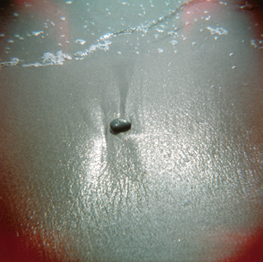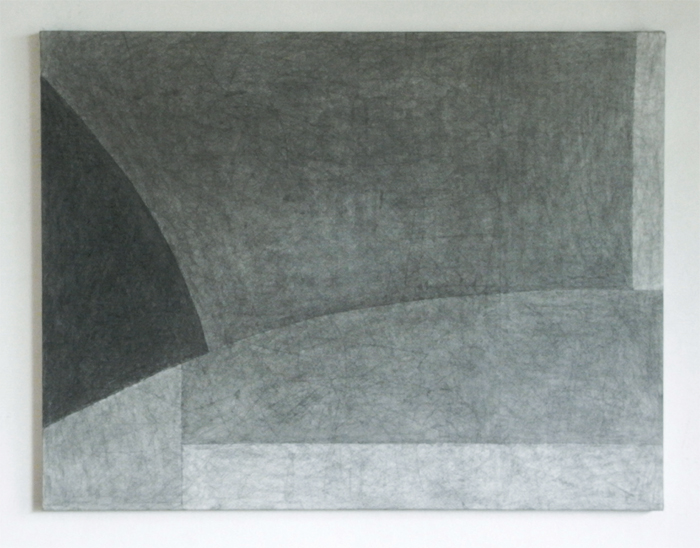
Curator FArthur Takehara
ProducerFKentaro Chiba
10th November- 22nd November
15:00-20:00
Opening Reception :15th November18:30`
¦This show is the first in three serial exhibitions
venue: Art Lab Akiba

No title@2014
50 x 65cm charcoal on paper
Scapeology on the Seashore
@This is the first solo exhibition of the drawings of Koh Uchimura, and focuses on his obsession with tribal or homespun weaving. Koh Uchimura uses charcoal, producing textures in the works that are softer than that of drawings in graphite pencils. Since charcoal hardly reflects the light, dark shades are deepened even darker as he adds mark upon mark. Viewers may feel as if their bodies are sinking into the picture.
@For Kentaro Chiba Uchimura's drawings and the weaving he adores share similarities; with the appearance of a strain like warp tension in certain pieces. In terms of composition, neither of them have a distinction between figure and ground.
@As for myself, his art makes me think of wind ripples on the surface of a dune. They are transient, unstable but exquisitely formed, and eternal. I envision ceaseless streams of fine grains of charcoal composing the image on paper.
Curator: Arthur Takehara
Scapeology on the Seashore
@Last winter, I discovered the fabric called Funzoe. The cloth is a huge sheet, stitched together from old rags by one of the minority groups in Southeast Asia. Seeing Funzoe, a complex mix of old fabric pieces, which were once abandoned, then gathered and reborn, I felt the strength and humility from within a decent and straight life.
@One of my motivations to create is to seek or generate new values from usually ignored and forgotten things, to do this from a different point of view and through patient observation. These works shown here are charcoal on paper, which is traditionally the under-drawing of oil paintings, but this time I use only charcoal from start to finish.
@The writing of Keiji Iwata has influenced me since I was an art student and first encountered his book. He consistently stressed the importance of Animism, which is the state before religions created their own gods. ¦‘I have been waiting for the day when every creature and thing in the universe can be a protagonist of their own world and start to talk about themselves and listen to others’ stories as well’ he wrote.
@My present works here were created under the influence of these factors relating to the primitive, but now my focus is shifting to different points, such as the total geometrical balance of shapes and texture in a monotone.
@I am always trying to work in the daylight. I am especially attracted by the transition of intuition in the time between dusk and darkness when what can be seen on a drawing sheet gradually turns into obscure and invisible objects. My perception is shifting from the outside to the inside, in other words from objects to myself. It is the time when I am directly facing up to my works.
¦Keiji Iwata “The era of Animism” iHouzoukan,1993j
Artist : Koh Uchimura
Weaving Drawing
@In art, we can classify expressions of the subconscious into two categories; the expression in speed and the emergence in delay. Automatism, pouring, dripping in paintings and music improvisation belong to the former. In the case of Koh Uchimura’s works, I think of the emergence of subconscious in delay.
When Koh Uchimura was a B.A. student at Musashino Art University, he changed courses from the fine art department to textile and dyeing. He did this to bring in a broader perspective for creation to his fine art. It was an inevitable decision for him.
In the case of dyeing and weaving, the design is often decided in advance, and something beyond an individual’s capability will emerge in an amalgamation of processes and repetition. The intimacy with material is closer than painting and the sensibility to touch is therefore greater. Dyeing and weaving are arduous processes, and in the dyers’ and weavers’ life and work, boundaries between apparent confrontations, between the personal and the social, between the inner and outer world, will often disappear and merge into the one. Some are ceaselessly asking about life with the same intensity as weaving continuously.
In Uchimura’s exhibition, rather than dyeing and weaving, he employs drawing where we see the sense of velocity in strong strokes, which is one of the essences of the technique. Equally we can see how he took time to build a drawing ground on paper with numerous accumulated charcoal strokes. He patiently waits until something comes from the other side before finishing strokes, which are not only automatic and quick but also realistic and inevitable, as if they were weft woven into warp. There are untold things in his works that elude me at present, but the show is the first in three serial exhibitions. I hope I will be able to discover the connecting thread at the end.
Producer: kentaro Chiba
